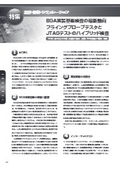The probe heads are arranged above and below, allowing for simultaneous in-circuit testing of both sides of the substrate. (Supported substrate size for inspection: up to 985×610)
The simultaneous use of upper and lower flying probes allows for a combination inspection of up to 6 probes, enabling the inspection of components that can make contact at both points on the top and bottom of the substrate. This model boasts world-class standards in speed and positioning accuracy while expanding the compatible substrate size to W635×D610mm. Additionally, by adding an optional split inspection function, it can also inspect long substrates up to W985×D610mm. It can accommodate component heights of up to 60mm and substrate weights of up to 10kg, making it suitable for inspecting substrates used in automotive, aerospace, and medical devices, as well as power boards and probe cards, which are larger and heavier. ★Evaluation tests can be conducted by bringing in substrates to the demo room at our Okayama headquarters★ A complete testing process is possible, including the creation of inspection programs, testing using actual substrates, and summarizing evaluation results. If you are interested, please apply through the 'Contact Us' section below.
Inquire About This Product
basic information
To ensure that electronic devices function correctly, the electronic circuit board within the device must operate normally. The electronic circuit board becomes operational when electronic components are correctly mounted on the printed circuit board (PCB) and power is supplied. The process of contacting a specialized probe to the electronic circuit board, which has electronic components mounted on it, and applying minute electrical signals for testing is called In-Circuit Testing (ICT), and the device used for this testing is referred to as an In-Circuit Tester. This testing checks the "connection reliability between electronic components and the board," the "values of individual mounted electronic components (such as resistors and capacitors)," and "diode polarity," without applying unnecessary load to the board itself. It is also known as MDA (Manufacturing Defect Analyzer). Main inspection contents: ● Solder shorts and opens ● Pattern disconnections ● Missing components ● Incorrect component values ● Reverse insertion of polarized components ● Lifted leads of ICs and connectors ● Operation verification of digital transistors, optocouplers, and Zener diodes ● Other simple function tests
Price range
Delivery Time
Applications/Examples of results
【Adopted Industries】 EMS, EMDS companies Semiconductor manufacturing equipment Communication infrastructure and servers Automotive, aircraft, and marine Medical devices Industrial machinery and robots FA machine tools Power generation and power systems 【Use Cases】 ■ Inspection of mass-produced items Connected to loaders/unloaders for automated/unmanned inspection even in large lots ■ Inspection of multi-variety small quantity substrates No need for dedicated jig manufacturing costs; easy identification of defective areas ■ Inspection of prototype substrates Function tests responsive to design changes (applying voltage to the substrate to confirm circuit operation (ON/OFF) and measure direct current) ■ Implementation confirmation inspection during model switching Confirmation of the mounting program for the first lot and checking for setup errors during model changes ■ Defect analysis inspection Inspection of substrates that failed functional tests and defect analysis of substrates that failed in the market Additionally, we have a track record of being utilized in various other applications. For more details, please contact your sales representative.
Detailed information
-

APT-1600FD
Line up(4)
| Model number | overview |
|---|---|
| APT-1600FD | Dual-side inspection compatible machine |
| APT-1600FD-A | Dual-side inspection compatible, inline machine (model with automatic transport conveyor) |
| APT-1600FD-SL | Dual-side inspection, large board compatible machine |
| APT-1600FD-SL-A | Dual-side inspection, large board compatible, inline machine |
catalog(17)
Download All Catalogs![Accelerating Inspection of Flying Probe Testers Using Deep Reinforcement Learning [Ehime University Collaborative Research Materials]](https://image.www.ipros.com/public/catalog/image/01/b78/706831/IPROS8285943113191609983.jpeg?w=120&h=170)


![Accelerating Inspection of Flying Probe Testers Using Deep Reinforcement Learning [Joint Research Material with Ehime University]](https://image.www.ipros.com/public/catalog/image/01/844/760295/IPROS14771536501121226558.jpeg?w=120&h=170)

News about this product(23)
Company information
Founded in 1894 as a textile company, Takaya Textile expanded and established its electronics division in 1966, starting the assembly of transistor radios. Today, in addition to contract manufacturing services (EMS) related to electronic devices, the company actively manufactures and sells various electronics, including in-circuit testers (printed circuit board inspection devices) and RFID (a technology that enables information exchange through short-range wireless communication from tags containing IC information), as well as IT consulting and system solutions, both domestically and internationally. We continue to evolve as a corporate group that contributes to societal development, with textiles and electronics as our dual pillars.





















![[Case Study] PCB Inspection for Aerospace and Defense Sector](https://image.www.ipros.com/public/product/image/633/2001490332/IPROS17197433194665772389.jpeg?w=280&h=280)
